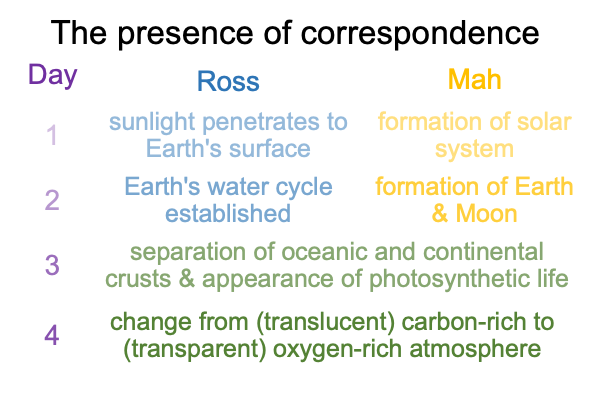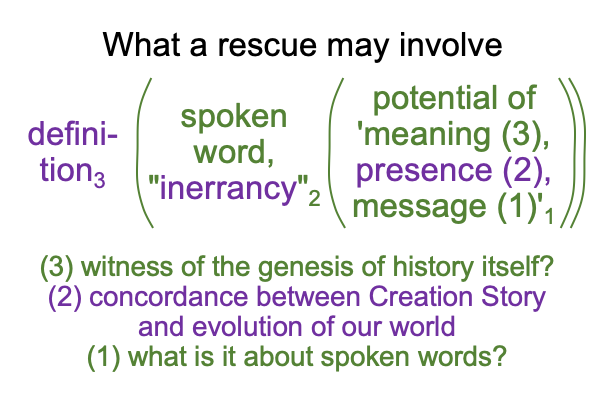0162 Old hands in the “Science vs. Religion” debate will immediately put Ross’s “moderate” (and what I call “artistic”) concordism in a box labeled “day-age correspondences”.
Everyone knows the game, “To name it is to know it.”
0163 Chapter 16 tries to launch a different name. Ross discusses “The Historicity of Genesis 1 -11”. Then, he goes through his version of day-age correspondences.
So, the box is to be labeled, “historicity”.
0164 Exercises in Artistic Concordism by Razie Mah (available at smashwords and other e-book venues) offers a different set of day-age correspondences.
Here is a list.

The correspondences for days five and six do not appear in the above list, Ross and Mah identify the same relevant epochs. Mah goes so far as to include correspondences between Genesis verses 26 through 31 and human evolutionary history.
The correspondences for days three and four match well. Ross discusses the epoch corresponding to day four in detail in chapter 17.
0165 The correspondences for days one and two do not match, because (from this examiner’s point of view) Ross has difficulty placing “the observer” near an accretion disk (for day one) or on the surface of a molten planetesimal that becomes the Earth (in day two). Yeah, in either case, if someone was at the location, that person would die before they could witness anything. Better to start with a visionary on the Earth when the sky becomes transparent enough to allow a distinction between day and night.
0166 In contrast, the observer, for Mah, may not actually be witnessing the corresponding epochs live (so to speak), but rather through a medium… like a big screen TV…. or the surfaces of the visionary’s occipital lobes. Just take a look at the text. God speaks. Someone besides the angels must be listening. And, if that someone is a human visionary, then some of the angels might think that God is offering them a raw deal. Yeah, here is a day-age concordance that can also serve as an introduction to John Milton’s Paradise Lost.
0167 Or, better, this day-age concordance introduces the version of Paradise Lost that would be produced as a totally random permutation when a trillion monkeys type on a trillion typewriters continually for a trillion years. Of course, the randomly produced version is not quite identical. Rumors are that the new title is Pair Of Dice Lost.
0168 And, that brings me back to the definition of the titular word, “inerrancy”.
Ross is not rescuing inerrancy with a scientific defense.
No, Ross is exploring a much more significant option. He is offering new life to the term, “inerrancy”. The rescue will be different for the Creation Story (Genesis 1-2.3) and for the Primeval History (Genesis 2.4-11).
0169 Here is a picture.

The application of artistic concordism as an empirio-schematic to the phenomena of day-age correspondences changes the presence (2) underlying the word, “inerrancy”.
The rescue of the Primeval History will revive the meaning (3) and the message (1) underlying the word.
